Brabejum stellatifolium

Author: Ivan Lätti
Photographer: Thabo Maphisa
Brabejum stellatifolium, the wild-almond, grows spreading branches covered in pale grey-brown, fairly smooth bark, reaching up to 8 m in height (SA Tree List No. 72). It is the only species in its (monotypic) genus. It is also the only South African member of the large and diverse Proteaceae family that bears a stone fruit.
B. stellatifolium resembles some Australian Proteaceae more than it does the South African members of its family. This reminds of the earth’s continual transformation, particularly the geographic era during which Africa and Australia both formed part of the supercontinent Gondwanaland, attached to each other until the Jurassic, about 180 million years ago.
The wild-almond is thought to hold yet another distinction, being the first South African indigenous tree that was planted locally in 1660. Planting South African species in Europe from seeds or cuttings taken on board from the Cape on many passing ships that sought interesting and marketable cargo, is quite another matter, happening from before Europeans colonised the Cape.
The wild-almond hedge that delineated the Dutch settlement border for dealing with Khoi neighbours, still exists in a small part. The heavy, convoluted stems of these old Kirstenbosch trees show where the original trees were planted.
The species distribution is in the southwest of the Western Province, from the Cape Peninsula northwards to the Cederberg and Clanwilliam, eastwards to Riversdale.
The tree is found on lower slopes of sheltered kloofs and valleys of the fynbos biome, often close to watercourses. It is not considered to be threatened in its habitat early in the twenty first century (Coates Palgrave, 2002; Leistner, (Ed.), 2000; iNaturalist; http://pza.sanbi.org; http://redlist.sanbi.org).

